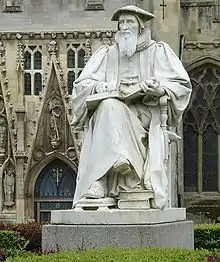Church of the Good Shepherd (Rosemont, Pennsylvania)
Church of the Good Shepherd of Rosemont, Pennsylvania, is a progressive and inclusive Episcopal parish church in the liberal Anglo-Catholic tradition.[1] It is part of the Episcopal Diocese of Pennsylvania and is located in the Philadelphia Main Line.
| Church of the Good Shepherd | |
|---|---|
.jpg.webp) | |
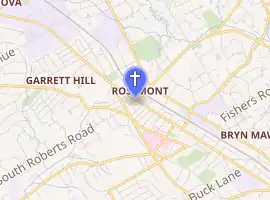
| |
| 40°1′28″N 75°19′29″W | |
| Location | 1116 E Lancaster Avenue, Rosemont, Pennsylvania |
| Country | United States |
| Denomination | Episcopal |
| Tradition | Anglo-Catholic[1] |
| Churchmanship | High church |
| Website | The Church of the Good Shepherd, Rosemont, Pennsylvania |
| History | |
| Status | active parish |
| Founded | 1869 |
| Consecrated | 1910 |
| Architecture | |
| Architect(s) | Baily & Truscott (Philadelphia) (main church); Samuel Fowler and Samuel Mountford (Trenton, New Jersey) (Baptistry, Cloister, and Lady Chapel) |
| Architectural type | Gothic Revival |
| Style | English Gothic |
| Groundbreaking | 1893 |
| Completed | 1894 |
| Specifications | |
| Bells | 11 in bell tower |
| Administration | |
| Parish | Church of the Good Shepherd |
| Diocese | Episcopal Diocese of Pennsylvania |
| Clergy | |
| Rector | Rev. Dr. Kyle Babin |
| Laity | |
| Organist(s) | Matthew Glandorf |
The parish proclaims that "Hate Has No Home Here" and welcomes everyone, including Episcopalians and those of other faith traditions, spiritual seekers, non-believers, LGBTQIA+ persons and members of other marginalized communities, and any who seek meditation, prayer, or refreshment in a place of peaceful beauty.[2]
.png.webp)
Art and architecture
.jpg.webp)
Entrance and Bell Tower
Above the main (north) entrance to the church is a polychrome statue depicting the boy Jesus as the Good Shepherd. The crenellated tower contains bells playing the Cambridge Quarters each quarter of the hour, as well as ringing the Angelus and chiming during the eucharistic consecration. The chime of 11 bells, donated in 1913, are playable from a console in the Lady Chapel. Ten of the bells are stationary; the largest (the 11th bell) can be swung.[3]
Nave and Stained Glass
_ca._1910.jpg.webp)
The nave comprises five bays and a clerestory with stained glass. In all, the building's stained glass includes 50 figurative windows and six ornamental windows.[4]
Rood Screen
.jpg.webp)
A large carved wooden rood screen surmounted with a crucifixion separates the chancel from the nave. The screen was added to the church in 1912. Its gates are by celebrated blacksmith Samuel Yellin (1884-1940).[5]
Chancel
The chancel enjoys a richly-decorated coffered ceiling.
High Altar and Reredos
The high altar is made of Caen stone, and was installed in 1905. In 1929 artist and parishioner George Fort Gibbs created seven paintings for the church's high altar reredos as a memorial to his parents. The center panel is a Virgin and Child, flanked by panels depicting other figures from the Christian era (left of the tabernacle) and Old Testament (right of the tabernacle): Saint Francis of Assisi; Saint Peter; King Saint Edward the Confessor (last king of the English House of Wessex); Moses; Aaron; and King David.[5]
Lady Chapel
There is a separate Lady Chapel entered at the top of the south aisle, dedicated in 1918. The space was originally a sacristy and choir room. The current limestone altar was installed in 1954. The tabernacle and triptych, as well as the carved double-desk, are by parishioner Davis d'Ambly, and date from the 1980s.[5]
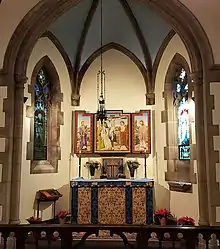
Baptistry
An octagonal baptistry with carved font and stained glass was added off the south side of the church in 1932. The chandelier is by Samuel Yellin, and the glazing and polychrome are by Valentine d'Ogries (1889-1959).[5]
War Memorial
The Memorial, created in 1942, honors parishioners who have served in the armed forces in and since World War II. It was installed at the urging of parishioner Lt. Gen. Milton Baker, who also established the nearby Valley Forge Military Academy and College.[5]
Crypt
There is a columbarium and small funerary chapel in the crypt of the church, along with a vault containing the coffins of benefactor Harry Banks French and members of his family.
Worship
The church building is open each day of the week for visits and meditation. Good Shepherd holds services on Sunday at 8:00 am (Low Mass) and at 10:30 am (Sung High Mass). Evening prayer is held Monday through Friday at 5:30 pm.
.jpg.webp)
As at other High Church, Anglo-Catholic churches, worship at Good Shepherd incorporates the later Catholic Revival's devotional and eucharistic practices:
- A robust program of classical and traditional Anglican church music in English and Latin during worship (see "External Links" below for examples posted on YouTube).
- Beautiful, elaborate eucharistic vestments.
- Eastward-facing orientation of the priest at the altar instead of the priest facing the people.
- Ringing of altar bells.
- Reading of the Last Gospel depending on the ecclesial season.
- Mixing of water with the sacramental wine.
- Use of incense during High Mass.
- Numerous altar candles.
- Multiple chancel lamps.
- Periodic Exhibition of the host in a monstrance.
- Reservation of the Eucharist in a central tabernacle behind the high altar.
Anglican Service Book
Good Shepherd is the publisher of the Anglican Service Book, which it has used in its worship services. The book is an Anglo-Catholic version of the Book of Common Prayer used in the Episcopal Church.
Music program
The organist and choirmaster is Matthew Glandorf, a graduate of and faculty member at the Curtis Institute of Music.[6]
The choir comprises a professional core with auditioned volunteer singers. The choir sings weekly at the 10:30 High Mass on Sunday, and at special liturgies throughout the year, including Advent, Christmas, Epiphany, Ash Wednesday, the solemn liturgies of Holy Week, Easter and Pentecost. The choir offers a sung setting of the Mass on most Sundays and feast days ranging from Palestrina and Victoria to Stanford and Parry and the great English cathedral repertoire, as well as sacred music being written for the church today such as James MacMillan, Eriks Esenvalds and local Philadelphia composers. The music program has a Choral Scholar Program for talented students from nearby colleges, including male and female choral scholars from, e.g., Bryn Mawr College, Villanova University, and Haverford College, to support them in their studies.[7]
Organ
The organ at Good Shepherd is an Austin, Op. 2613 (1977), with three manuals and 57 ranks of pipes.
History
The parish was founded in 1869 as part of the Anglo-Catholic Oxford Movement revival in the Anglican Church,[8] and was admitted to the Diocese of Pennsylvania in 1871. Its original church building was on the North side of Lancaster Avenue, just east of the present football stadium of Villanova University. Through a donation of $27,000 (approximately $748,000 in 2018 dollars) from parishioner Harry Banks French of the Smith, Kline & French company,[9] the present church building was designed by the Philadelphia architectural firm of Baily & Truscott,[10] and constructed between 1893 and 1894 in the Gothic Revival style of a 14th-Century English country church. The first services were held in 1894, and the building was consecrated in 1910.[11]
Good Shepherd Hospital
The parish set up Good Shepherd Hospital in the 1870s, originally to care for children whose parents could not afford to give them medical services. In 1903 the name was changed to the Home and Hospital of the Good Shepherd, and in 1915 admissions were restricted to boys between 7 and 14. The Hospital was conducted as a parochial institution until June 1922 when it merged with the Church Farm School, an Episcopal Church institution farther west in the Philadelphia suburbs.[12]
Move from Radnor to Rosemont
The original church building near Villanova was in use for about 20 years. It had been informally intended to be, in part, a memorial to two distinguished Episcopal bishops (Jackson Kemper and Samuel Bowman). A window honoring the bishops was installed in the church. In the 1890s, the vestry decided to move to a more spacious location in neighboring Rosemont, Pennsylvania, and received the donation from Harry Banks French to erect what is today the church building.[lower-alpha 1]
Rectors
| Name | Years |
|---|---|
| Henry Palethorp Hay | 1869 - 1883 |
| Arthur B. Conger | 1883 - 1912 |
| Charles Townsend Jr. | 1912 - 1930 |
| Thomas A. Sparks | 1930 - 1932 |
| William P.S. Lander | 1933 - 1962 |
| James H. Cupit, Jr. | 1963 - 1971 |
| George William Rutler | 1971 - 1978 |
| Andrew Craig Mead | 1978 - 1985 |
| Jeffrey N. Steenson | 1986 - 1989 |
| David Moyer | 1989 - 2002 |
| vacant[lower-alpha 2] | 2002 - 2012 |
| Richard C. Alton | 2012 - 2014 |
| Ian Montgomery | 2014 - 2018 |
| Kyle Babin | 2020 – present |
Gallery
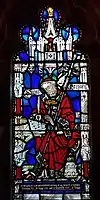 Window, St. Gregory the Great
Window, St. Gregory the Great Detail of carved baptismal font cover
Detail of carved baptismal font cover.jpg.webp) The boy Jesus as the Good Shepherd; image above the North door of the church
The boy Jesus as the Good Shepherd; image above the North door of the church.jpg.webp) Marian Votive Shrine, Mother of the Good Shepherd. Carved in Caen stone, it was installed in 1923 in honor of a parishioner's child who died in infancy
Marian Votive Shrine, Mother of the Good Shepherd. Carved in Caen stone, it was installed in 1923 in honor of a parishioner's child who died in infancy.jpg.webp) Annunciation window
Annunciation window.jpg.webp)
.jpg.webp) Arms of the parish, including the Red Rose of Lancaster
Arms of the parish, including the Red Rose of Lancaster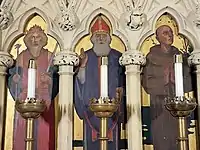 Detail of reredos, L to R, King Saint Edward the Confessor (last king of the English House of Wessex), Saint Peter the Apostle, Saint Francis of Assisi
Detail of reredos, L to R, King Saint Edward the Confessor (last king of the English House of Wessex), Saint Peter the Apostle, Saint Francis of Assisi 19th century Cathedra (bishop's chair) in Sanctuary showing arms of the Diocese of Pennsylvania
19th century Cathedra (bishop's chair) in Sanctuary showing arms of the Diocese of Pennsylvania.jpg.webp) Church Door at Good Shepherd showing (from left) arms of the parish; Marian monogram; the IHS Christogram; and arms of the Episcopal Diocese of Pennsylvania
Church Door at Good Shepherd showing (from left) arms of the parish; Marian monogram; the IHS Christogram; and arms of the Episcopal Diocese of Pennsylvania.jpg.webp) Triptych in the Lady Chapel
Triptych in the Lady Chapel.jpg.webp) Sacristy Painting
Sacristy Painting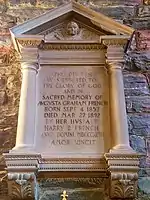 Augusta French Memorial, in whose memory the Church was built
Augusta French Memorial, in whose memory the Church was built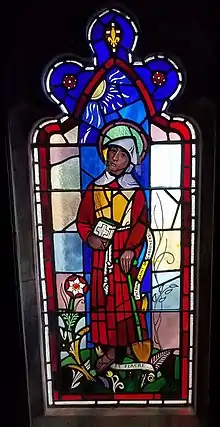 St. Fiacre Window
St. Fiacre Window
Notes
- Although the memorial windows were to be removed and used in the new church, some members of the congregation objected, arguing that they had donated funds for the original church with the understanding that it alone would be a memorial to the two bishops, and that a charitable trust existed for that purpose, prohibiting the move to Rosemont. Litigation followed, including two decisions by the Supreme Court of Pennsylvania, finally permitting the move. The supreme court ultimately ruled that the parish's 1870 articles of incorporation described it as existing for the purpose of worship, but not as a vehicle for memorializing persons, and that the vestry had control of the property subject to the Canon Law of the Episcopal Church. In the first case,[13] the supreme court enjoined the vestry from the move from Radnor. In the final case,[14] the supreme court reversed itself and allowed the move.
- In 2002 David Moyer was deposed from the priesthood by the bishop of Pennsylvania, although he remained de facto rector of Good Shepherd until 2011, when the parish was returned to control of the Diocese of Pennsylvania by court order and Moyer vacated the premises.
See also
- Harvey Butterfield (former assistant)
- Church architecture
- Churchmanship
- Gothic architecture
References
- "About Anglo-Catholicism". www.goodshepherdrosemont.com. 2020. Retrieved October 22, 2020.
- "Church of the Good Shepherd". Retrieved November 24, 2019.
- Church of the Good Shepherd (2019), Treasures of Heaven, The Art and Architecture of Good Shepherd, Rosemont, a Self-Guided Tour
- "Census of Stained Glass Windows in America". Retrieved November 29, 2019.
- Church of the Good Shepherd 2019.
- "Matthew Glandorf, Curtis Institute Faculty". Retrieved December 9, 2018.
- "Choir at Good Shepherd". Retrieved November 27, 2019.
- It is Pennsylvania non-profit corporation entity number 66578, incorporated 23 May 1870 (Records of the Pennsylvania Secretary of State).
- "An Historical Sermon Delivered in the Memorial Church of the Good Shepherd Rosemont Pa. By the Rector the Rev. Arthur B. Conger A.M. On the Third Sunday After Trinity June 12th, 1910". Retrieved December 9, 2018.
- "Baily & Truscott (fl. 1890-1904)". Retrieved December 24, 2018.
- Coates, Edward Osborne. An historical sketch of the Church of the Good Shepherd, Rosemont, Pennsylvania, 1869-1934 (unknown publisher, 1935).
- "Church of the Good Shepherd". Retrieved December 9, 2018.
- "Cushman v. Rector etc. of Church of Good Shepherd of Radnor, 162 Pa. 280, 29 A. 872 (1894)". 1894. Retrieved December 10, 2018.
- "Cushman v. Rector etc. of Church of Good Shepherd of Radnor, 188 Pa. 438, 41 A. 616 (1898)". 1899. Retrieved December 10, 2018.
Further reading
- The Anglican Service Book, 1991, ISBN 0-9629955-0-9
- Brown, Stewart J. & Nockles, Peter B. ed. The Oxford Movement: Europe and the Wider World 1830–1930, Cambridge: Cambridge University Press, 2012.
- Chadwick, Owen. Mind of the Oxford Movement, Stanford: Stanford University Press, 1960.
- Faught, C. Brad. The Oxford Movement: a thematic history of the Tractarians and their times, University Park, PA: Pennsylvania State University Press, 2003, ISBN 978-0-271-02249-9
- Rzeznik, Thomas F. Church and Estate: Religion and Wealth in Industrial Era Philadelphia. University Park, PA: Pennsylvania State University Press, 2013, ISBN 978-0-271-05967-9
- Walworth, Clarence A. The Oxford Movement in America. New York: United States Catholic Historical Society, 1974 (Reprint of the 1895 ed. published by the Catholic Book Exchange, New York).
External links
- Official website
- Church of the Good Shepherd, Rosemont PA on Facebook
- Church of the Good Shepherd, Rosemont, Pennsylvania on YouTube
- The Magnificat / CHH Parry / Good Shepherd, Rosemont PA on YouTube
- Psalm CL / Chant by Charles Villiers Stanford / Good Shepherd, Rosemont, PA on YouTube
- The Nunc Dimittis / CHH Parry / Good Shepherd, Rosemont PA on YouTube
- Come, Gracious Spirit (Good Shepherd, Rosemont) on YouTube
- Non ministrari, sed ministrare: a tour of Good Shepherd, Rosemont
